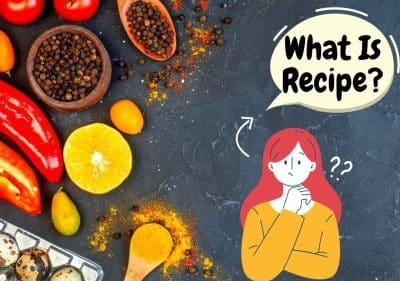Since long ago, Recipes have been an essential element of human civilization, providing a guide for making delightful foods that tempt our taste buds.
Recipes are the key to transforming straightforward items into delectable dishes, whether they are passed down through generations or are found in cookbooks and websites.
We’ll delve into the essence of recipes in this blog, looking at their importance, organization, and the creative freedom they provide.
Unleashing the Power of Recipes
The creative possibilities of ingredients can be unlocked through recipes. They offer a well-organized manual that details exact measurements, cooking methods, and a process to guarantee successful results.
In essence, recipes serve as road maps that lead us through the process of producing a dish, enabling even inexperienced cooks to create delectable and gratifying meals.
Structure and Components
A list of ingredients and directions may appear to be all that a recipe is at first look. They do, however, include important components that add to their efficiency. Let’s examine the key elements that comprise a recipe:
Ingredients: The ingredients are the fundamental components of any recipe and are what give food its flavor and texture. Every component, from fresh produce and pantry staples to spices and seasonings, adds something special to the finished dish.
Measurements: To ensure uniformity, recipes include specified measurements for each item. Precision is essential in cooking. The correct balance of flavors and textures is achieved by using these measurements, which can be made in the form of weight (grams, ounces) or volume (cups, teaspoons).
Instructions: A recipe’s step-by-step instructions provide guidance for the preparation of food by describing methods like chopping, sautéing, baking, and more. By providing instructions on when to add ingredients, how long to cook them for, and at what temperature, they aid in producing a perfect symphony of tastes.
Cooking Times and Temperatures: To make sure that ingredients are cooked to perfection, recipes frequently contain suggested cooking times and temperatures. These recommendations offer a foundation, although alterations may be necessary along the way due to individual preferences and differences in equipment.
Additional Hints and adaptations: Many recipes come with helpful hints and advice from seasoned chefs, offering details on potential adjustments, omissions, and inventive adaptations. These suggestions enable people to explore and give the dish their own unique touch.
The Importance of Spices in Recipes
Providing a variety of flavors that can elevate even the most basic ingredients into exceptional dishes, spices are nature’s gift to our taste buds. Let’s examine how spices affect the taste experience:

Taste Sensations: Spices have a variety of taste sensations, including sweet, savory, spicy, bitter, and fragrant flavors. They can provide a dish with depth, complexity, and balance, delighting the senses and enticing the palate.
Aromatic Delights: Spices are recognized for their alluring fragrances, which can arouse our senses even before we take the first mouthful. They create anticipation and improve the whole dining experience by filling the air with enticing aromas.
Flavor Layering: Spices enable us to stack tastes in dishes to create a pleasing fusion of taste experiences. They can make a dish extraordinary by adding warmth, richness, tanginess, or a light kick.
Spices have cultural significance since they cross geographic boundaries and are essential to various civilizations’ culinary traditions. Here’s why they’re so significant to culture:
Culinary Identity: Spices help different areas and nations create their distinct flavors and culinary identities. Spices are an essential component of cultural cuisine, sustaining traditions and bridging generations. Examples include the bright curry blends of India, the Middle Eastern mixtures with their distinctive aromas, and the hot peppers of Latin America.
Cultural Exchange: Spices have long been highly valued commodities that have facilitated trade routes, exploration, and cultural exchange between civilizations. In search of spices, people embarked on journeys, drew maps of the world, and changed the world’s food, weaving a tapestry of flavors.
Spices not only tempt our taste receptors, but they also provide a number of health advantages. They are regarded as a useful addition to recipes for the following reasons:
Antioxidant Powerhouses: High quantities of antioxidants are present in many spices, which protect the body from oxidative stress and lower the chance of developing chronic diseases.
Anti-inflammatory Properties: Spices with anti-inflammatory qualities have the potential to improve general health and wellbeing. They might contribute to lowering the risk of diseases associated with inflammation and assisting in reducing inflammatory bowel disease.
Digestive improve: For millennia, people have utilized spices like cumin, ginger, and turmeric to improve digestion and support gut health. They can lessen bloating, encourage the synthesis of digestive enzymes, and calm the digestive tract.
Spices that Boost Metabolism: Some spices, such as cinnamon and cayenne pepper, are said to have the ability to increase metabolism. When included in a balanced diet, they may improve weight management by increasing calorie burn, regulating blood sugar levels, and increasing insulin sensitivity.
The Creative Freedom of Recipes
While recipes offer structure, they also give you plenty of room in the kitchen for creativity and self-expression. Once we understand the fundamentals of a cooking, we may explore and modify it to fit our tastes. Here are a few methods in which cooking foster ingenuity in the kitchen:
Ingredient Substitutions: Recipes can be modified to account for dietary restrictions, allergies, or personal tastes by substituting other ingredients. Ingredients can be changed, switched, or removed while still preserving the flavor of the dish with a little experimentation.
Enhancements to Flavor: New flavor profiles can be developed using recipes as a base. The flavor of conventional recipes can be improved and given a distinctive twist by the addition of herbs, spices, condiments, or supplementary ingredients.
Presentation and Garnishes: While cooking instructions are provided in recipes, plating and presentation are places where you can express your creativity. The overall dining experience can be improved by experimenting with various garnishes, arranging the dish attractively, and adding visual appeal.
Fusion and innovation: By fusing flavors and cooking methods from many civilizations, fusion dishes can be made by combining recipes from numerous culinary traditions. This enables the development of innovative culinary experiences that represent our globalized society.
In conclusion, a recipe is much more than just a list of directions. They enable us to embark on culinary journeys, turning uncooked components into delectable dishes that feed the body and the soul. By comprehending how a cooking is put together. Thanks for reading, and we hope to see you again here soon. Be sure to follow The TR Recipe. Also follow us on Pinterest, Texas Roadhouse Recipe.

